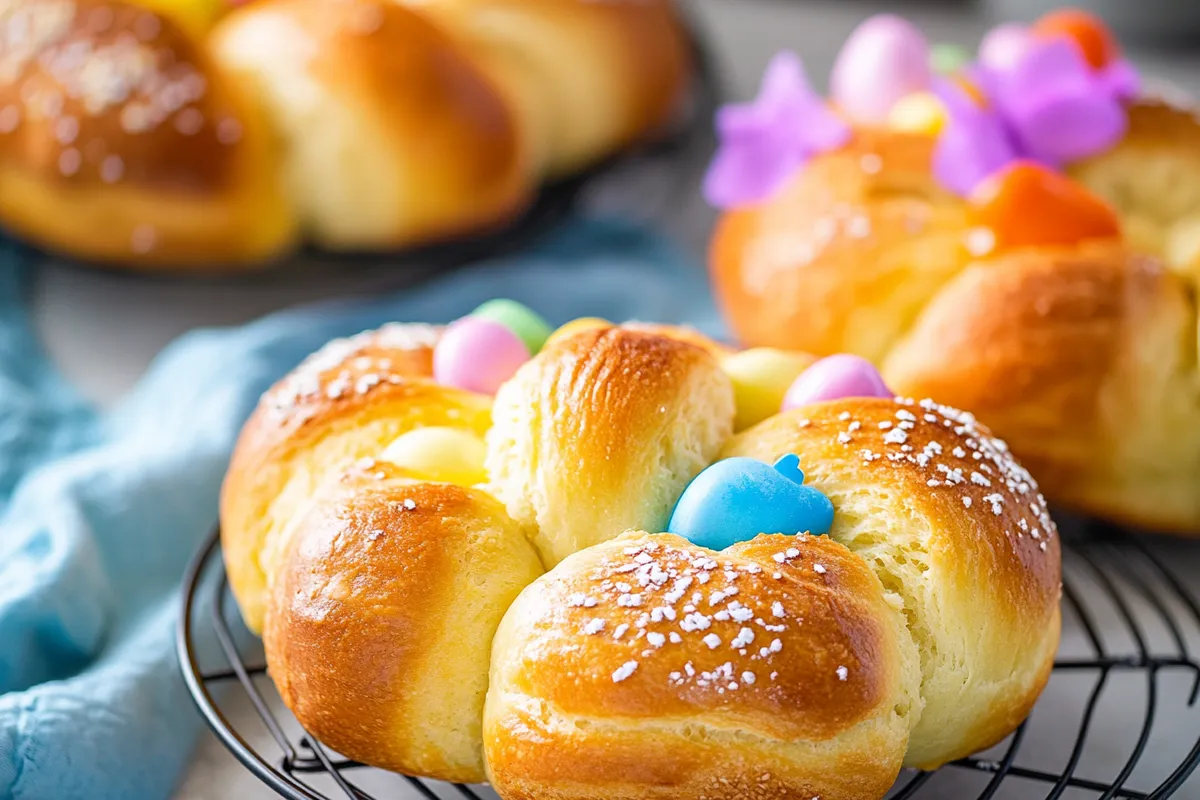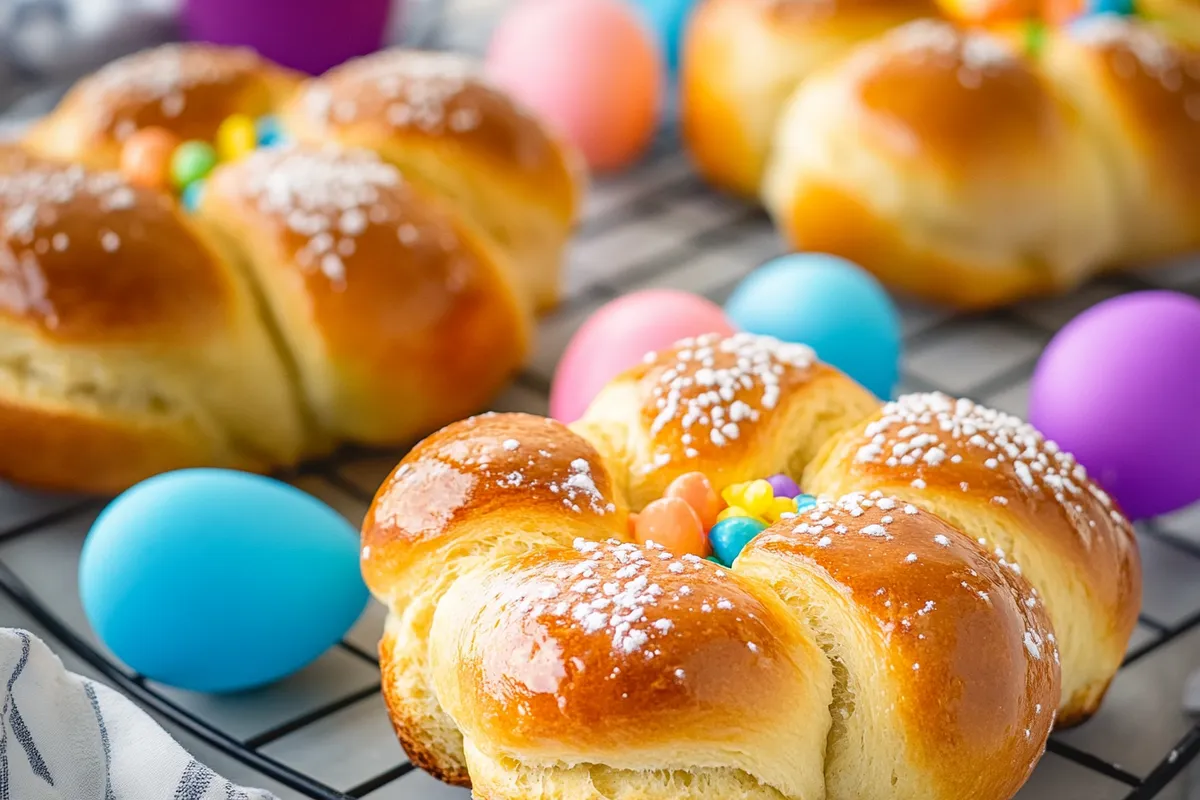Easter Bread: A Traditional Recipe for the Holiday

Easter Bread is more than just a delightful pastry; it embodies the spirit of celebration and togetherness during the holiday season. With its soft, braided texture and subtle sweetness, this traditional bread captivates the taste buds of young and old alike. Each family often has its own cherished recipe, passed down through generations, offering a personal touch to the bustling Easter brunch tables.
Variations abound, from adding vibrant citrus zest for a fresh twist to incorporating colorful sprinkles or dyed eggs for an eye-catching presentation. For those looking to experiment, think about infusing your dough with fragrant spices like cinnamon or nutmeg, or even trying a savory iteration with herbs and cheese.
To achieve the perfect loaf, remember to knead the dough until it becomes impossibly smooth and elastic, and allow it to rise in a warm, cozy environment for the best texture. Let this beautiful bread not only be a treat for your palate but also a centerpiece that sparks joy and conversation during your Easter festivities.
Ingredients for Easter Bread:
This delightful Easter bread recipe is perfect for celebrating the holiday with friends and family. Whether you choose to enjoy it plain or adorned with colorful toppings, here’s your essential ingredient list for a serving size of 8–10 people.
Bread Base Ingredients:
- 4 cups all-purpose flour
- 1 cup milk, warmed to about 110°F
- 1/2 cup granulated sugar
- 1/4 cup unsalted butter, softened to room temperature
- 3 large eggs
- 1 packet (2 1/4 teaspoons) active dry yeast
- 1 teaspoon salt
- 1 teaspoon vanilla extract
- 1/2 teaspoon ground nutmeg (optional)
For the Egg Wash:
- 1 large egg
- 1 tablespoon milk or cream
Add-ins and Flavor Variations:
- 1/2 cup currants or raisins (for a touch of sweetness)
- 1/2 cup chopped candied citrus peel (for a zesty flavor)
- 1 teaspoon lemon zest (for a refreshing aroma)
- 1 teaspoon almond extract (for a nutty depth)
- Colorful sprinkles or a light glaze made from powdered sugar and milk (for decoration)
Toppings and Finishing Touches:
- 1/4 cup sliced almonds (for added crunch)
- 2 tablespoons granulated sugar (to sprinkle on top before baking for a sweet crust)
Feel free to get creative with your Easter bread! You may substitute whole wheat flour for a healthier twist or even experiment with different types of milk, such as almond or coconut, for a unique flavor. Adding spices like cinnamon or cardamom can also elevate the taste profile.
Consider shaping your dough into different festive designs, such as a braided loaf or a round wreath. This not only adds to the presentation but also allows for personalized touches to celebrate the season.

How to prepare Easter Bread:
Start by gathering all your ingredients. You will need flour, sugar, yeast, milk, butter, eggs, and salt. Ensure everything is fresh and ready to use for the best results.
Activate the Yeast
In a small bowl, combine warm milk and sugar. Add the yeast and stir gently. Allow this mixture to sit for about 5 to 10 minutes. It should become foamy, indicating that the yeast is active and ready for use.
Mix the Wet Ingredients
In a large mixing bowl, melt the butter and let it cool slightly. Once cooled, add the activated yeast mixture, eggs, and remaining sugar. Stir until everything is well combined and smooth.
Combine with the Dry Ingredients
In a separate bowl, whisk together the flour and salt. Gradually add the dry ingredients to the wet mixture. Use a wooden spoon or spatula to combine, mixing until a soft dough forms. This may take around 5 minutes.
Knead the Dough
Transfer the dough to a floured surface. Knead it for about 8 to 10 minutes, or until it becomes smooth and elastic. If the dough is sticky, sprinkle a bit more flour as needed. This step is crucial for developing gluten, which gives the bread structure.
First Rise
Place the kneaded dough in a greased bowl and cover it with a damp cloth. Allow it to rise in a warm place until it doubles in size. This should take about 1 to 1.5 hours, depending on the temperature of your kitchen.
Shape the Bread
Once the dough has risen, punch it down gently to release air bubbles. Divide the dough into three equal pieces. Roll each piece into long strands, about 12 inches each. Braid the strands together and tuck the ends under to form a loaf shape.
Second Rise
Place the braided loaf on a greased baking sheet. Cover it again with a cloth and let it rise for another 30 to 45 minutes. During this time, preheat the oven to 350°F (175°C).
Bake the Easter Bread
Bake the loaf in the preheated oven for 25 to 30 minutes or until golden brown. To check for doneness, tap the bottom of the loaf; it should sound hollow. Allow it to cool on a wire rack before slicing.
Tips for the Perfect Easter Bread
Maintain the Right Temperature
To achieve a soft and fluffy texture, it is crucial to maintain the correct temperature during the bread-making process. First, ensure your ingredients are at room temperature. Cold eggs or dairy can slow yeast activation. Let milk and butter sit out for about an hour before use. When proofing the yeast, use warm water or milk (between 100°F to 110°F). Too hot can kill the yeast, while too cold will not activate it. During the proofing stage, find a warm, draft-free spot. A slightly warmed oven, turned off, works well for this purpose.
Use Quality Ingredients
The foundation of a delicious bread lies in the quality of ingredients. Opt for fresh yeast instead of dried if possible. Fresh yeast contributes to a better rise and flavor. Choose unbleached flour over standard white flour. It has higher protein content, which aids in gluten formation. Select high-quality butter and eggs for richness; organic options are preferable. If your recipe calls for citrus zest, use fresh zest rather than dried for more vibrant flavor.
Suitable Substitutions for Dietary Restrictions
If you or your guests have dietary restrictions, there are suitable substitutions to consider. For a dairy-free version, replace milk with almond or oat milk. Use plant-based butter to replace regular butter. To make the bread vegan, choose egg alternatives like flaxseed meal or chia seeds mixed with water. This swap helps bind the ingredients together without using eggs. For a gluten-free bread, use a gluten-free flour blend. Just ensure it has xanthan gum for proper texture.
Enhancing Flavor and Presentation
Customize your bread with various flavor enhancements. Add spices like nutmeg or cinnamon into the dough for warmth and depth. For a beautiful presentation, consider braiding the dough into intricate shapes before baking. Topping it with a simple icing made of powdered sugar and milk gives it a lovely shine. Don’t forget to add colorful sprinkles for a festive touch. Experiment with fillings like chocolate chips or dried fruits to surprise your guests.
By following these tips, your Easter bread will surely impress.
Storage Tips for Easter Bread:
After you bake a delicious batch of Easter bread, storing it properly helps maintain its freshness and flavor. Here are some practical tips to ensure your bread stays moist and tasty.
Optimal Storage Conditions
Store your Easter bread in a cool, dry place. Avoid exposure to direct sunlight and heat, as these factors can cause the bread to dry out quickly. Use a bread box or a pantry shelf that stays consistently cool. If you prefer, wrap the bread in a clean kitchen towel, which allows it to breathe while keeping excess moisture at bay.
Using Plastic Wrap or Containers
If you want to keep your bread soft for an extended period, consider wrapping it tightly in plastic wrap. Ensure that no air pockets remain inside the wrap. Alternatively, you can place the wrapped bread in an airtight container. Both methods protect the bread from air, which leads to staleness.
Refrigeration Considerations
While many people think of refrigerating bread, it’s often better to avoid it unless you live in a very humid environment. Refrigerators can cause bread to become stale more quickly due to the cool temperatures. If you must refrigerate, wrap the Easter bread tightly in plastic wrap to minimize moisture loss.
Freezing for Long-Term Storage
If you can’t finish your Easter bread within a few days, consider freezing it. Slice the bread into individual portions for easier thawing later. Wrap each piece in plastic wrap, and then place them in a freezer-safe bag or container. This method allows you to pull out only what you need without losing the entire loaf to freezer burn. When you’re ready to enjoy it again, simply let it thaw at room temperature or warm it in the oven.
Shelf Life of Easter Bread
Homemade Easter bread typically lasts about 3 to 5 days at room temperature when stored correctly. When refrigerated, it can keep for about a week, while freezing can extend the life to about three months. Always check for signs of spoilage, such as mold or an off smell, before consuming any leftover bread.
By following these storage tips, you can savor your Easter bread longer, ensuring every bite remains as delightful as when it first came out of the oven.
Related Recipes to Try Alongside Easter Bread
If you enjoy the rich, sweet flavors of Easter Bread, you might want to explore some complementary recipes that enhance your festive table. Here are a few delightful options that will pair beautifully with this traditional treat.
- Hot Cross Buns: These spiced sweet rolls are often associated with Easter. Like Easter Bread, they feature a blend of spices and citrus zest. The signature cross on top adds a touch of warmth, making them a perfect choice to serve together.
- Carrot Cake: This moist, flavorful cake embodies the spirit of spring. Its use of fresh carrots along with spices ties in well with the fruity and nutty elements of Easter bread. A rich cream cheese frosting will elevate any dessert spread.
- Spring Vegetable Quiche: Balance the sweetness of bread with a savory quiche filled with seasonal vegetables. The buttery crust and creamy texture create a harmonious contrast to the sweet flavors on your table.
- Simnel Cake: Another traditional Easter dessert, this cake features layers of marzipan and is often garnished with eleven marzipan balls, representing the apostles. The fruity nature and festive appearance resonate well with the celebratory aspect of Easter Bread.
- Honey Glazed Ham: For a savory option, a honey glazed ham brings a hearty touch to your Easter feast. The sweet glaze harmonizes with the indulgent flavors found in bread, creating a delightful combination of tastes.
These recipes not only share similar ingredients and flavors but also celebrate the essence of Easter. Incorporating them into your meal will create a festive and memorable experience for everyone at your table.
Frequently Asked Questions:
What is Easter Bread made of?
Easter Bread, often known as festive bread, is typically composed of simple ingredients such as flour, sugar, yeast, eggs, butter, and milk. This enriched dough often features additions like citrus zest, vanilla, or spices to enhance its flavor. Some families may incorporate raisins, nuts, or colored sprinkles for decoration, making their holiday loaf a unique centerpiece.
How is Easter Bread traditionally prepared?
The preparation of festive bread usually begins with activating the yeast, followed by mixing the ingredients to form a soft dough. After kneading, the dough is left to rise until it doubles in size. Once it has risen, it can be shaped into braids or round loaves before undergoing a second rise. Finally, the bread is baked until golden brown and typically brushed with an egg wash for a beautiful finish.
What does Easter Bread symbolize?
Easter Bread often symbolizes resurrection and new life due to its association with the Easter celebration. Its sweet, rich flavor and festive appearance reflect the joy and renewal of spring. In various cultures, this loaf carries specific meanings, such as the representation of the Holy Trinity or the cycle of life.
Can I make Easter Bread without eggs?
Yes, you can make a dairy-free and egg-free version of festive bread using substitutes like flaxseed meal or applesauce to achieve similar binding properties. Additionally, plant-based milk alternatives can be used to create a rich dough suitable for those following a vegan diet.
How long does Easter Bread last?
Festive bread can typically be stored at room temperature for about 3-5 days in an airtight container. For longer storage, it can be wrapped tightly in plastic wrap and frozen. Allow it to thaw overnight in the refrigerator before enjoying the delicious flavors again.
Are there variations of Easter Bread in different cultures?
Absolutely! Many cultures have their unique recipes and variations of Easter Bread. For instance, Italian “Colomba di Pasqua” is a dove-shaped bread, while Greek “Tsoureki” features a rich, sweet dough often adorned with red-dyed eggs. Each variation reflects local traditions, ingredients, and baking techniques, making the celebration even more special.
Conclusion:
In summary, making Easter Bread is a rewarding experience that embodies the spirit of the holiday. This delightful recipe emphasizes simplicity, allowing even novice bakers to create a stunning centerpiece for their festive table. One of the standout features of this bread is its remarkable flexibility; you can tailor it to your taste by incorporating various flavors or adding seasonal ingredients like candied fruits and nuts. Additionally, feel free to experiment with shapes and sizes, making it truly your own. The customization options available ensure that each loaf can tell a personal story, whether it’s a family tradition or a new creation. As you gather with loved ones this Easter, savor the joy of sharing homemade bread that celebrates both flavor and creativity. Dive into this culinary adventure and discover how easy and enjoyable it is to create a memorable Easter experience!
